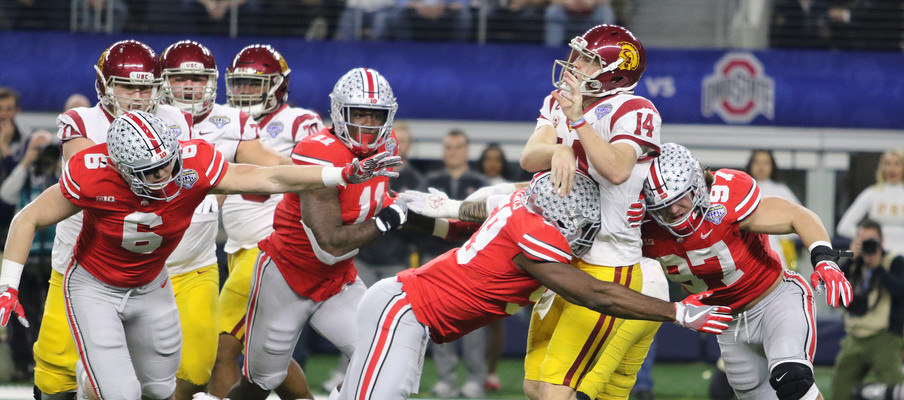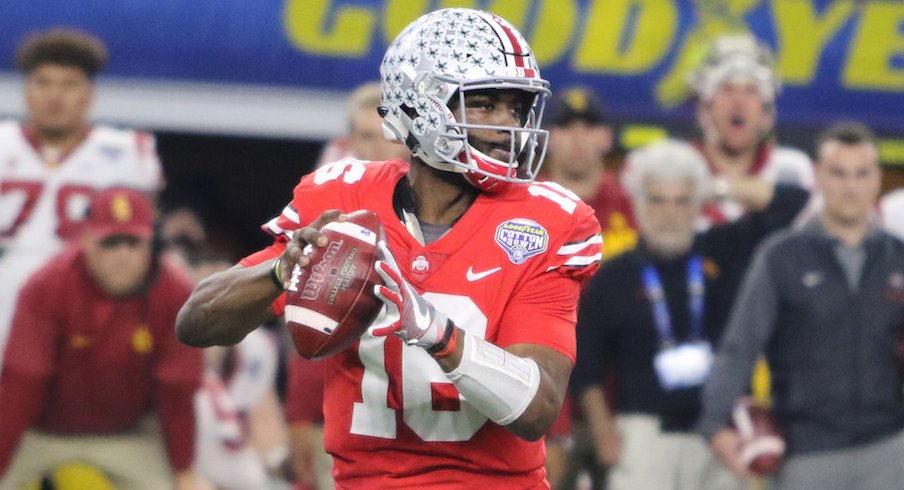The final grades for Ohio State’s 2017 football season are in.
Although the Buckeyes didn’t necessarily ace their final exam, they nonetheless finished their season with another grade-bolstering victory by defeating USC, 24-7, in the Cotton Bowl.
Ohio State might not have accomplished the ultimate goal of playing for a national championship this season, but the Buckeyes nonetheless had a largely successful season, winning 12 of their 14 games, capping the year off with a Big Ten title and a New Year’s Six bowl victory.
All of that, from Ohio State’s three wins over top-10 teams (Penn State, Wisconsin and USC) to the two losses (to Oklahoma and Iowa) that kept it out of the championship game, are factored in as the Buckeyes receive their final assessments for the season that was.
As we have done over the course of the season, each Ohio State position group and special teams unit is graded for its respective performance for the season as a whole, while the report card concludes by giving the Buckeyes an overall grade for their 2017 season.
Quarterbacks: B
Let’s start by acknowledging what will lead some to discredit this grade right from the beginning: There’s clearly room for, and arguably a need for, improvement for Ohio State at the quarterback position. Mediocre play from J.T. Barrett led to stagnancy for Ohio State’s offense at times this season, including in the Cotton Bowl, when the Buckeyes failed to score a single point in the second half. That’s enough to make a case that this grade should be lower, especially considering the expectations that surrounded Barrett as a fourth-year starting quarterback with a new quarterbacks coach and offensive coordinator, and as an Ohio State quarterback in general.
At the same time, though, it can also be said that Barrett had the most statistically prolific season for a quarterback in Ohio State history, as he broke his own school records for total offense (3,851 yards) and total touchdowns (47) in a season. In becoming just the fourth quarterback in Ohio State history to win 12 or more games in a season (Craig Krenzel, Troy Smith or Braxton Miller), Barrett also became the winningest quarterback for a career in school history.
Barrett’s play was held to a high standard, as all Ohio State quarterbacks are, which led to frequent criticism of his play this season. His limitations in the vertical passing game held the Buckeyes offense back at times, which leads to the belief that Dwayne Haskins or whoever Ohio State’s next quarterback is could take the offense to another level. But while it’s reasonable to expect more from the quarterback of one of the top programs in the country, Barrett was nonetheless one of the top quarterbacks in college football this season – tying for second in total touchdowns while ranking ninth in passer rating (160.1) – and had one of the most productive seasons in school history, which is enough to earn him and his position group a B.
Running Backs: A-
While it’s fair to question or even knock Ohio State’s usage of its running backs this season, there isn’t much to take away from the running backs themselves, who made positive plays much more often than not when they had the ball in their hands this season.
Ohio State couldn’t have asked for much more from J.K. Dobbins, who broke the Buckeyes’ true freshman rushing record with 1,403 yards for the season. He’ll look to make a bigger impact in 2018 in the passing game, where he only had 135 receiving yards and has room to grow as a pass blocker, but the exciting thing about Dobbins is how productive he has already been while he might be only scratching the surface of his potential.
Mike Weber’s overall production this season could be viewed as a disappointment, as he surely expected to run for more than 626 yards, but he took advantage of many of his opportunities – he just didn’t have as many opportunities because of Dobbins’ emergence. Weber, who showed more speed and big-play ability in 2017 than he did in 2016, averaged more yards per carry this season (6.2) and ran for more touchdowns (10) while also gaining more receiving yards (94) on less than half as many catches.
Wide Receivers: C+
The Buckeyes began the season with a goal of having six wide receivers who could all interchangeably make plays, and they were able to accomplish that goal. With a strong showing by Austin Mack in the Cotton Bowl, Ohio State finished the year with six wide receivers who each had 300 receiving yards or more. Parris Campbell, K.J. Hill, Terry McLaurin, Johnnie Dixon and Binjimen Victor all showed playmaking ability over the course of the year, and even walk-on C.J. Saunders – the seventh man in the rotation – was impressive in limited action.
The negative, however, is that Ohio State never found a Michael Thomas or Devin Smith for its receiving corps who could regularly make plays in the downfield passing game or be a consistent go-to target. Victor, Mack, Dixon and McLaurin all flashed that ability, but not consistently; Campbell showed big-play ability with the ball in his hands, but struggled to make plays as a downfield receiver, while Hill was the Buckeyes’ most reliable short-yardage and intermediate target but made most of his plays inside 10 yards from the line of scrimmage.
Barrett (and Ohio State’s offensive play callers) drew most of the criticism for Ohio State’s limited vertical passing game, and it’s certainly possible that a new quarterback and/or an adjusted offensive system could lead to more downfield playmaking opportunities for the Buckeyes’ wide receivers. At the same time, though, Ohio State’s wide receivers struggled from some untimely drops and were unable to consistently get open when downfield passing plays were called, so the continued development of this group as a whole and the emergence of a go-to playmaker or two is crucial for the Buckeyes offense to reach its potential in 2018.
Tight Ends: C
Marcus Baugh demonstrated noteworthy improvement this season as a blocker and made his fair share of plays in the passing game, most notably against Penn State, when he caught the game-winning touchdown in Ohio State’s most thrilling victory of the season.
With that being said, Baugh’s per-game receiving production in 2017 was nearly identical to his pass-catching production in 2016, and he ranked just 10th among Big Ten tight ends in receiving yards this year as a result. Furthermore, Ohio State did not have another consistent playmaker at the tight end position this year, making its production from the position continue to be below-average.
Although Rashod Berry flashed some playmaking ability and Luke Farrell also saw some playing time, neither one of them caught a pass in Ohio State’s final seven games of the season. Baugh was a solid short-yardage and intermediate receiving option and mostly effective run blocker, but rarely a game-changer. For the Buckeyes to get more impact from their tight ends in 2018, they will likely be counting on incoming freshman Jeremy Ruckert to make an immediate impact.
Offensive Line: A
The offensive line’s grade could have dropped after the Cotton Bowl, which was not one of its better games of the season. The Buckeyes gave up three sacks to the Trojans and did not impose their will in the running game between the tackles as effectively as they had most of the year. As well as the Buckeyes performed the rest of the season, however, they earned an A for the year even without acing their final exam.
Great offensive line play is too often taken for granted, and Ohio State’s shouldn’t be. The Buckeyes’ front five was largely dominant in both pass protection and run blocking down the stretch of the season, unlike in 2016, when Ohio State’s pass blocking up front was too often a liability.
Billy Price was the best center in the country, winning the Rimington Trophy, while Jamarco Jones and Michael Jordan gave the Buckeyes two first-team All-Big Ten performers on the left side of the line. Right tackle Isaiah Prince might have been the Buckeyes’ most improved player this season. Branden Bowen started the year strong at right guard, while Demetrius Knox finished it with equally strong play after Bowen went down with a season-ending injury.
Defensive Line: A
Considering that Ohio State defensive coordinator Greg Schiano described the Buckeyes’ defensive line as being better than an NFL defensive line before the season, there’s a part of me that feels the defensive line didn’t always play up to that hype this season, and should receive a lower grade as a result.
When a unit finishes the season as arguably the most productive group at its position in the entire country, however, that unit deserves nothing less than an A.
Thanks to a truly dominant defensive line performance in the Cotton Bowl, in which the Buckeyes had eight sacks and 14 tackles for loss, Ohio State tied to lead the entire Football Bowl Subdivision with 114 tackles for loss and ranked third in the FBS with 45 sacks. Ohio State’s defensive linemen, led by Nick Bosa and Sam Hubbard, accounted for more than 64 percent of those tackles for loss and more than 76 percent of those sacks (while of course, occupying blockers and creating disruption that helped lead to most of the others).
Ohio State’s defensive line also led the way for a rushing defense that held opponents to just 2.9 yards per carry this season, the fourth-lowest average allowed by an FBS defense.

Linebackers: C
Outside of Barrett because of his prominence as the quarterback, no Ohio State position group received more criticism this season than its linebackers, who repeatedly struggled in pass coverage, most notably in the Buckeyes’ two losses to Oklahoma and Iowa.
Despite having two returning starters in Jerome Baker and Chris Worley, the Buckeye linebackers took a step back in their performance this season in their first year under new position coach Bill Davis. They specifically had trouble with covering tight ends and running backs in the passing game, while they didn’t make as many plays around the line of scrimmage either.
The linebackers did make some positive strides near the end of the season, though, as Baker started to re-emerge as a more active playmaker, Worley’s play improved as he moved back outside from the middle linebacker position and Tuf Borland and Malik Harrison made their share of plays as their roles increased. Going into 2018, however, the Buckeyes will be looking for much improved play in pass coverage as well as more consistent tackling from this position group.
Defensive Backs: B
No Ohio State offensive or defensive position group demonstrated more improvement over the course of the 2017 season than its secondary, which appeared to be a major weakness for the Buckeyes at the beginning of the year but made consistent strides as the season progressed.
Denzel Ward was one of the most dominant cornerbacks in the entire country this season. Damon Webb had a strong senior season, leading the Buckeyes with five interceptions, while Jordan Fuller also emerged as a reliable player in both pass coverage and run support on the back end.
The Buckeyes clearly missed Ward when he decided to sit out the Cotton Bowl, in which they allowed USC to pass for 356 yards. But while fellow cornerbacks Kendall Sheffield and Damon Arnette did not perform to the same level as Ward, they did show steady improvement over the course of the year, particularly Sheffield, who was a clear liability at the beginning of the season but provided solid coverage for the Buckeyes down the stretch.
Place Kicking: C
Sean Nuernberger went 17-of-21 on field goals this season – the same exact number of makes and attempts as Tyler Durbin in 2016, though Nuernberger’s misses came at less inopportune times – and made all 71 of his extra point attempts. All in all, Nuernberger was solid, but made only one field goal all season of longer than 40 yards, as Ohio State didn’t show much inclination to attempt longer kicks. The blocking unit in front of him also had its moments, allowing two blocked field goals. So while this unit wasn’t bad, it didn’t do anything to show itself as being any better than average.
Punts: A
Thanks to an excellent first season from redshirt freshman punter Drue Chrisman, the only player to punt in a game for the Buckeyes this year, Ohio State ranked 12th in the nation with an average of 44.2 yards per punt. As good as Chrisman was, hitting 15 punts of 50-plus yards and 25 of his 51 punts inside the opponent’s 20-yard line, the punt coverage unit was also excellent, holding opponents to just seven returns of 54 yards. Regression for the punting unit would not have come as a surprise following the departure of Cameron Johnston, but Chrisman helped ensure that the Buckeyes continued to be excellent in this area.
Kickoffs: B-
Ohio State’s most profound improvement in any phase of the game this season came on kickoffs, where the Buckeyes had well-documented struggles in the first two months of the season but were excellent at the end of the season.
True freshman kicker Blake Haubeil struggled to execute Ohio State’s preferred coffin corner-style kickoff for much of the season – and was replaced twice by Sean Nuernberger, who had even worse results as two of his kickoffs were returned for touchdowns – but he figured it out by the end of the year, especially in the Buckeyes’ final two games, when Ohio State held Wisconsin and USC to 17.4 yards per return on 11 returns while Haubeil did not have a single touchback or kickoff out of bounds.
Thanks to a kickoff coverage unit full of explosive athletes that also became much more consistent in its coverage by the end of the year, Ohio State finished the season ranked 10th in the FBS in yards allowed per kickoff return (17.4), even with the two return touchdowns allowed.
Kickoff Returns: C-
Following the decision to replace Parris Campbell as kickoff returner with Mike Weber, for reasons that were never made entirely clear, Ohio State never made a significant impact in this phase of the game for the rest of the season. While Campbell averaged 36.6 yards per return on nine returns – which would have been the second-highest average in the FBS if he had enough returns to qualify – Weber averaged just 15.9 yards per return on nine returns, never coming close to breaking one for a long gain.
Ohio State still hasn’t returned a kickoff for a touchdown since 2010, but its lack of a significant impact from its kickoff return game at all during the second half of the season is what draws a low grade here.
Punt Returns/Blocks: D+
Ohio State had one enormous play from this unit that was not only a game-changing play, but a season-changing play, when Denzel Ward blocked a punt that sparked its comeback against Penn State. Outside of that play, however, this unit continued to be a weakness, as Ohio State ranked just 98th in the FBS with 5.5 yards per punt return.
K.J. Hill did provide an upgrade over Dontre Wilson and Jalin Marshall in terms of sure-handedness, but he had his moments too, including in the Cotton Bowl, when he made a poor decision to attempt to field a punt and muffed it, setting up USC’s only touchdown of that game. The Buckeyes will need to go back to the drawing board once again to look for a stronger punt return game in 2018.
Overall: B+
What’s been established in previous report cards will be repeated once again in the final report card of the season: To earn an overall A grade against the standard on which Ohio State is graded, the Buckeyes have to seriously contend for a national championship, or at least come as close as can be expected.
This year, the Buckeyes were expected to make the College Football Playoff and make a run at a national title, but were kept out by their pair of regular-season losses. It’s true that Ohio State had a case for making the playoff even with those two losses, and had the committee made a different decision, the Buckeyes could well be on their way to a national title game now. But the Buckeyes cost themselves a championship chance with those two losses, including their 31-point loss to an Iowa team they shouldn’t have lost to at all, and those downgrade their 2017 season.
All of that said, the Buckeyes’ 2017 season can still be considered largely a success, considering that they won 12 games – including a Big Ten Championship Game win and a Cotton Bowl win – and are headed toward finishing the season with another top-five ranking. The Buckeyes won crucial games against Michigan, Penn State and Michigan State along the way, establishing their supremacy in the Big Ten East, and proved they could bounce back by stringing together impressive winning streaks after each of their losses.
The standard for success at Ohio State is as high as it comes, which makes anything less than the top of the college football pyramid at least a mild disappointment, but the Buckeyes’ ability to overcome those disappointments and finish the season strong earns them a high B for 2017.


